Today, universities seeking to improve awareness and boost enrollment face a unique challenge: how to stand out among many competitors and reach the right people online. The key to success lies in the effectiveness of the university’s marketing strategies. Search Engine Optimization remains critical for reaching potential students, faculty, and researchers. When executed strategically, university SEO strategies can elevate its online presence, making it more visible to its target audience.
This comprehensive guide delves into the most effective university SEO strategies, exploring the nuances of effective educational marketing in the digital landscape. We’ll discuss the importance of keyword research tailored to academic offerings, the role of quality content in engaging prospective students, and the significance of technical SEO in ensuring your site is easily navigable by both users and search engines. Additionally, we’ll examine the power of local SEO for institutions looking to attract students to their physical campuses.
By integrating these strategies, you can enhance your university’s visibility online and create meaningful connections with potential students. If you’re wondering, “How do I leverage SEO for my website?” you’ll find that the answer is manifold and involves a delicate balance between effective keyword research, high-quality content, location-sensitive strategies, and technical SEO strategies. Whether you’re looking to increase enrollment, boost your institution’s reputation, or connect with a global audience, the insights provided here will equip you with the knowledge you’ll need to leverage SEO in your educational marketing arsenal.
SEO In An Educational Marketing Context: An Introduction
What is SEO strategy for universities? Search Engine Optimization remains a critical component of effective educational marketing, aiming to optimize a website for higher rankings in search engine results. This makes it easier for potential students, faculty, and stakeholders to find information about academic programs, research opportunities, and campus life. Effective university SEO strategies can significantly boost your online presence, attracting a broader audience by ensuring your pages rank highly for relevant queries.
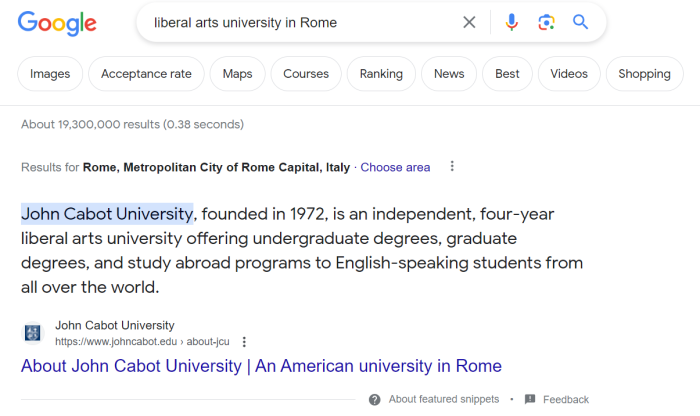
Source: Google
John Cabot University is the top search engine reply page for “liberal arts university in Rome”. As you can see in the search above, they occupy prime search engine real estate and are most likely to be clicked.
The significance of SEO for universities extends beyond visibility. It is pivotal in enhancing your reputation, increasing enrollment numbers, and showcasing academic achievements and research breakthroughs to a global audience. By leveraging SEO, you can target prospective students based on their search behavior and interests, leading to more personalized and engaging marketing efforts. Furthermore, SEO analytics provide invaluable insights into user behavior and preferences, enabling institutions to refine their offerings and communication strategies accordingly.
In an increasingly competitive educational landscape, SEO is vital for you to stand out. It helps reach potential students more efficiently and supports the institution’s broader goals of knowledge dissemination and community engagement. By prioritizing SEO, you can ensure that your digital marketing efforts are effective and aligned with your mission to educate and inspire the next generation of leaders. Let’s explore how you can implement effective university SEO strategies for increased brand awareness and higher enrollment.
Are you curious about the process of improving university online visibility? Get in touch with us to learn more about our services.
Effective University SEO Strategies For Your School
Gone are the days of cramming keywords into blog content. Effective SEO now requires a more intentional approach involving various methods. Thorough keyword research, quality content creation, local SEO strategies, and different technical SEO strategies combine to drive quality traffic and generate leads. Let’s look at how these tactics function as part of a successful university marketing strategy.
1. Data-Driven Marketing: Keyword Research
Keyword research refers to the process of identifying the terms and phrases that prospective students and their families are using to search for educational opportunities. This fundamental SEO practice is critical for schools because it ensures that your digital content aligns with the search queries of their target audience. Thorough keyword research allows you to understand what prospective students are seeking and can position your institution as the right solution. By integrating these keywords into their website content, blog posts, and online advertisements, you can significantly improve their visibility on search engine results pages (SERPs). This enhanced visibility is essential for attracting more website visitors, generating leads, and increasing enrollment.
In addition, keyword research allows you to understand search intent, which enables the development of content that addresses the needs and questions of their audience, whether they’re looking for course information, application details, or campus life insights. Keyword research also fosters a competitive advantage. Various popular SEO tools on the market allow you to see what keywords your competitors are ranking for. Incorporating them into your content makes you visible in a crowded market. Try these practical best practices to boost the effectiveness of your keyword research.
Start with keyword research tools: Tools like Google Keyword Planner, SEMrush, and Ahrefs can help identify relevant keywords, their search volume, and their competition level. As discussed above, competitor analysis can help you identify gaps in your content that you can address to improve your search engine rankings.
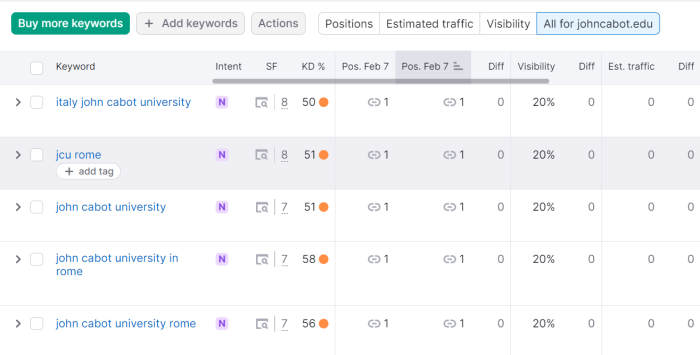
Source: SemRush
Example: Here, you can see the top keywords for John Cabot University displayed on the SemRush keyword manager dashboard. Tools like SemRush allow you to track keyword positions, clicks, and difficulty, providing a relatively accurate picture of your school’s visibility and estimated traffic. This information is crucial for effectively optimized content planning.
- Try to focus on long-tail keywords: These are longer and more specific keyword phrases that visitors are likely to use when they’re closer to making a decision. They often have less competition and can drive more targeted traffic.
- Optimize for Local SEO: For schools that draw a significant portion of their student body from the local area, optimizing for local search terms and including location-based keywords can be highly effective.
- Regularly Update Content: Search engines prefer fresh, relevant content. As new research emerges and content trends change, you must keep up to continue ranking high. Regularly updating your site with new, keyword-optimized, and fact-checked content can help maintain and significantly improve your SERP rankings.
- Monitor and Adjust Strategies: SEO is a continuous endeavor. You should continuously monitor your keyword performance and adjust your strategies as needed based on analytical insights.
2. Improve The Quality And Relevance Of Your School’s Marketing Content
As you aim to boost your enrollment numbers, you must recognize the pivotal role of quality and relevant educational content in your marketing strategy. Your content should inform prospective students about the institution’s academic programs, campus life, and values and position yourself as a thought leader in education. For universities, creating content that resonates with their target audience involves deeply understanding prospective students’ needs, interests, and aspirations.
Quality educational content is accurate, engaging, and informative. It provides prospective students a clear understanding of what the university offers, including detailed descriptions of courses, faculty expertise, research opportunities, and student success stories. This content should also highlight unique aspects of the university, such as specialized programs, partnerships with industries, and support services for students. By presenting this information in an accessible and compelling manner, universities can inspire prospective students to envision themselves thriving on campus. Be sure to incorporate the following best practices as you strive to create content that converts.
- Start By Understanding Your Audience: Research to understand your target audience’s demographics, interests, and concerns. Use this information to tailor your content to meet their specific needs. Many schools find it easier to create content that appeals to prospective students using targeted student personas.
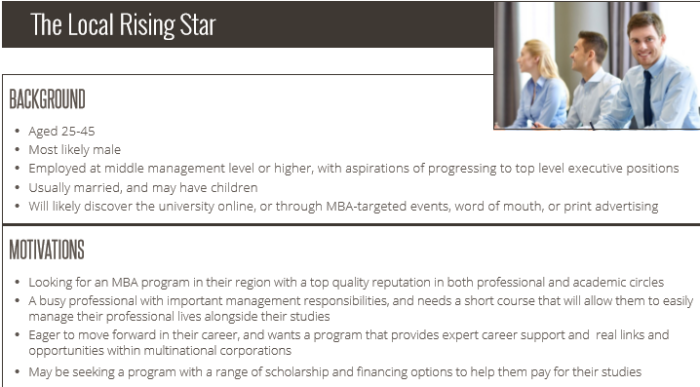
Source: Higher Education Marketing
- Showcase Real Stories: Even as AI-generated content gains popularity, people continue to respond to human stories. How can you incorporate them into your content for a genuine connection with your audience? Use testimonials, interviews, and case studies of current students and alumni to provide authentic insights into the university experience that you offer. For example, John Cabot University often shares student spotlight blogs that provide prospective students with detailed, personalized insight into the institution’s quality educational experience. Engaging content is a significant part of developing a solid SEO strategy.
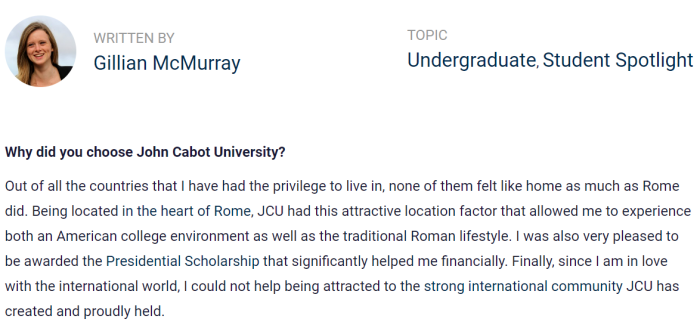
Source: John Cabot University
- Utilize Various Formats: Diversify your content using videos, blogs, infographics, and virtual tours to cater to different information processing styles and preferences. This variety can engage users more effectively and provide a fuller picture of university life.
- Leverage Social Media: Use social media platforms to share your content widely and engage directly with prospective students. Platforms like Instagram, Twitter, and Facebook can be excellent avenues for showcasing campus life, events, and announcements.
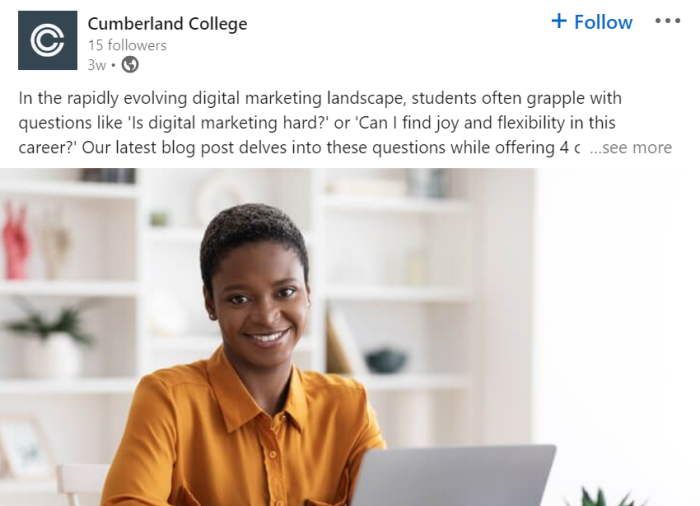
Example: Cumberland College, a reputable digital marketing school, regularly shares relevant social media content with its target audience and provides value. This post, for example, explores the potential concerns of the average digital marketing student and includes several high-ranking keywords.
- Measure and Adjust: A common theme throughout your SEO strategy should be constant analysis and adjustment. Constantly measure the performance of your content to understand what resonates with your audience. Use these insights to refine your strategy and content creation.
- Optimize for SEO: Incorporate relevant keywords into your content to improve visibility on search engines. Be sure that you incorporate keywords in a way that doesn’t compromise the natural flow of your content, as this tampers with the authenticity of your voice and renders you less credible to your audience. SEO-optimized content makes it easier for prospective students to find your content when searching for information related to their educational interests.
3. The Value Of Local SEO For Universities
Though educational marketing is becoming increasingly globalized, particularly with the dawn of online learning, location still matters. Local SEO is incredibly valuable for universities looking to attract students, especially those from the surrounding region or considering relocation for their studies. After all, location is crucial in many students’ decision-making processes regarding universities. It focuses on optimizing a university’s online presence to appear in local search results, which is crucial for reaching prospective students who use search engines to find information about higher education institutions near them.
Local SEO will help your university to increase visibility among local searchers. When prospective students search for “universities near me” or “best university in [Location],” universities optimized for local search are more likely to appear in top search results, attracting more clicks and visits. Local SEO enables universities to target their marketing efforts towards a specific geographic audience. This mainly benefits institutions that want to attract students from their city, state, or region. Here’s an example of what that looks like:
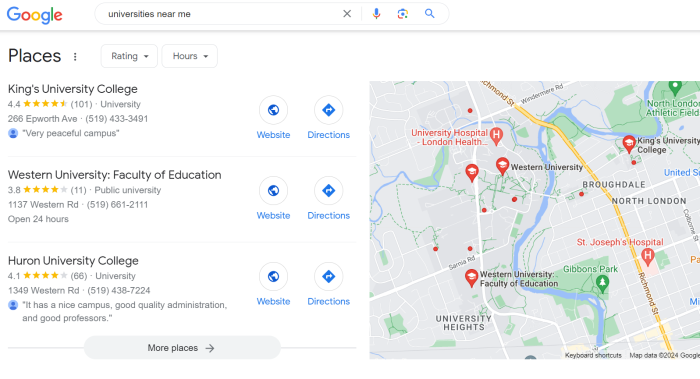
By claiming and optimizing listings on local directories and review sites (such as Google My Business), universities can enhance their online presence, offering more touchpoints for engagement with prospective students. Local SEO can also help you to establish yourself as an integral part of your local community. This will undoubtedly appeal to prospective students as it shows them that you are well-connected and can introduce them to a broader community, thus boosting their career prospects upon graduation. Be sure to incorporate these effective best practices into your marketing strategy.
- Optimize Google My Business Listing: Google My Business is a location-sensitive tool that helps you to manage how your institution is displayed on search results. Ensure your Google My Business (GMB) profile is accurate, complete, and optimized. Include detailed information about your university, such as address, phone number, website, and hours of operation. Regularly update your GMB profile with news, events, and photos to keep it engaging. Here’s an example from the Applied Academy Of Pharmaceutical Sciences that offers detailed location-sensitive information about the institution as a search result.
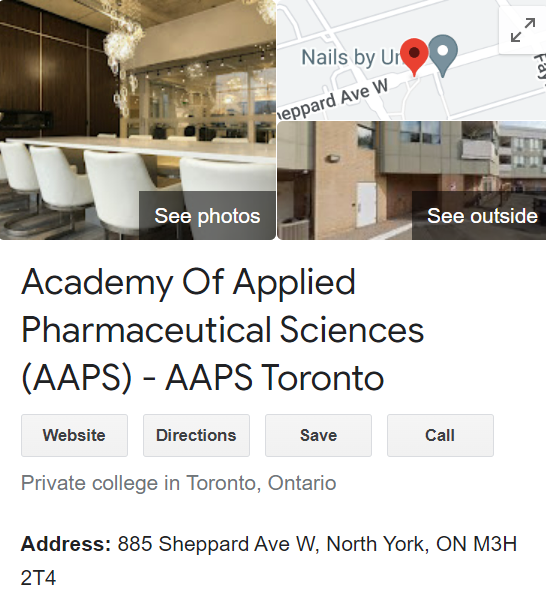
Source: Google
- Use Local Keywords: Incorporate local keywords into your website’s content, meta titles, and descriptions. Include the city, state, or region your university is targeting, especially in key sections of your website, like the homepage and contact page.
- Create Location-Specific Content: Develop content highlighting your university’s involvement with the local community, local events, or region-specific programs. This boosts local SEO and shows your commitment to the community. For example, the post below highlights some key unique selling points for a university prep school in Toronto designed to appeal to a target audience specifically interested in this location.
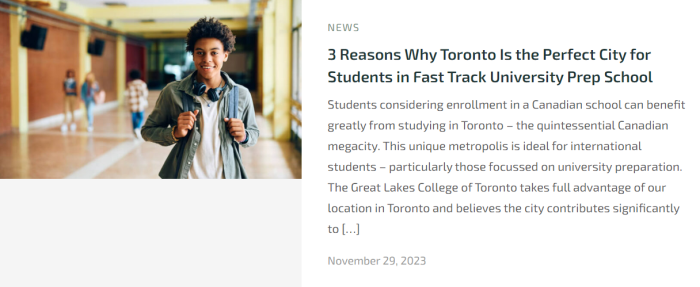
Source: Great Lakes College Of Toronto
- Acquire Local Backlinks: Gain backlinks from local businesses, organizations, and media outlets. This enhances your university’s local relevance and authority, positively impacting local search rankings.
- Local Structured Data Markup: Use schema markup (structured data) on your website to provide search engines with specific information about your university, such as location, courses, and events. This can help enhance your visibility in local search results.
4. Technical SEO: What Is It And How Do You Implement It?
Technical SEO is vital to optimizing university websites. Technical SEO refers to optimizing website and server aspects that help search engine spiders crawl and index your site more effectively. This aspect of SEO strategy is crucial for improving a website’s visibility in search engine results pages (SERPs). For universities seeking to boost their online presence, technical SEO is indispensable, as it ensures that their rich educational content and resources are accessible and understandable to both search engines and potential students.
Technical SEO improves visibility by ensuring that a website is easily navigable by search engines. This way, it’s more likely that the site’s content will be correctly indexed and ranked. Technical optimizations often lead to faster load times, mobile optimization, and an overall better user experience, which can reduce bounce rates and encourage prospective students to explore more of the site. Here are some technical SEO strategies to implement.
- Ensure Mobile-Friendliness: Ensure their websites are responsive and provide a good user experience on mobile devices.
- Improve Site Speed: Site speed is a ranking factor crucial for user experience.
- Secure Your Site with HTTPS: Security is a top priority for users and search engines.
- Create an XML Sitemap: An XML sitemap helps search engines understand your website structure and discover all its pages, improving the crawling process.
- Use Structured Data Markup: Implementing schema markup helps search engines better understand your pages’ content, which can enhance your visibility in search results through rich snippets and other search features.
- Optimize Crawl Budget: Ensure search engines can efficiently crawl your most essential pages by optimizing your site’s architecture, fixing broken links, and using the robots.txt file wisely to block pages that do not contribute to your search presence.
- Eliminate Duplicate Content: Use canonical tags to indicate the preferred version of a page to search engines, helping to prevent issues with duplicate content that can dilute your site’s value.
- Ensure Clean, Descriptive URLs: Use easy URLs for users and search engines to understand, incorporating relevant keywords where appropriate.
So, what have we learned today? SEO remains a vital tool for increasing visibility and lead generation. However, more than a rudimentary use of keywords is required to drive results. Your university SEO strategy must be varied, including thorough research, quality content creation, local strategies, and technical SEO techniques. By implementing the best practices we’ve explored today, you can expect higher visibility, engagement, and more quality leads.







